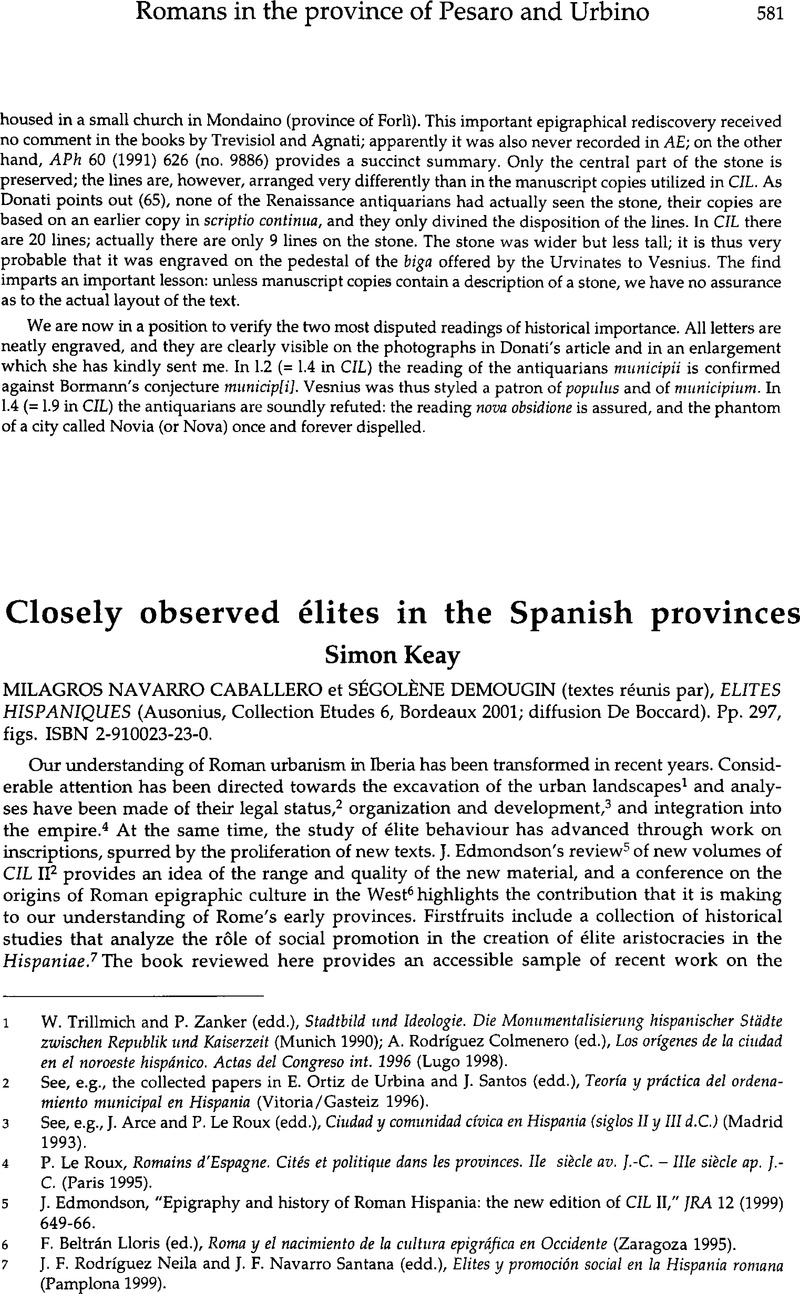No CrossRef data available.
Article contents
Closely observed élites in the Spanish provinces - Milagros Navarro Caballero et Ségolène Demougin (textes réunis par), ELITES HISPANIQUES (Ausonius, Collection Etudes 6, Bordeaux 2001; diffusion De Boccard). Pp. 297, figs. ISBN 2-910023-23-0.
Published online by Cambridge University Press: 16 February 2015
Abstract

- Type
- Reviews
- Information
- Copyright
- Copyright © Journal of Roman Archaeology L.L.C. 2002
References
1 Trillmich, W. and Zanker, P. (edd.), Stadtbild und Ideologie. Die Momtmentalisieriing hispanischer Städte zwischen Republik und Kaiserzeit (Munich 1990)Google Scholar; Colmenero, A. Rodríguez (ed.), Los orígenes de la ciudad en el noroeste hispánico. Actas del Congreso int. 1996 (Lugo 1998)Google Scholar.
2 See, e.g., the collected papers in de Urbina, E. Ortiz and Santos, J. (edd.), Teoría y práctica del ordenamiento municipal en Hispania (Vitoria/Gasteiz 1996)Google Scholar.
3 See, e.g., Arce, J. and Roux, P. Le (edd.), Ciudad y comunidad cívica en Hispania (siglos II y III d.C.) (Madrid 1993)Google Scholar.
4 Roux, P. Le, Romains d'Espagne. Cités et politique dans les provinces. Ile siècle av. J.-C. – IIIe siècle ap. J.-C. (Paris 1995)Google Scholar.
5 Edmondson, J., “Epigraphy and history of Roman Hispania: the new edition of CIL II,” JRA 12 (1999) 649–66Google Scholar.
6 Lloris, F. Beitrán (ed.), Roma y el nacimiento de la cultura epigráfica en Occidente (Zaragoza 1995)Google Scholar.
7 Neila, J. F. Rodríguez and Santana, J. F. Navarro (edd.), Elites y promoción social en la Hispania romana (Pamplona 1999)Google Scholar.
8 This topic has been treated at much greater length by Chamizo, J. C. Saquete, Las elites sociales de Angusta Emerita (Cuadernos Emeritenses 13, 1997)Google Scholar (a work cited by Ramírez Sádaba).
9 S. J. Keay, “The development of towns in Early Roman Baetica,” in id. (ed.), The arcliaeology of Early Roman Baetica (JRA Suppl. 29, 1998) 55-86.
10 E.g., Rodríguez Colmenero (ed.) (supra n.1)
11 Thomas, E. and Witschel, C., “Constructing reconstruction: claim and reality of Roman rebuilding inscriptions from the Latin West,” PBSR 47 (1992) 135–78Google Scholar
12 Lloris, F. Beltrán, “Writing, language and society: Iberians, Celts and Romans in Northeastern Spain in the 2nd and 1st centuries BC,” BillInstClassStudLon 43 (1999) 131–51Google Scholar.
13 However, Lefebvre's argument that the Albinus Albui f. attested at Emerita as a provincial flamen should be connected to the Q. Lucceius Albinus attestd at Olisipo is very speculative, and does not take into account the crucial question of the date of the inscription from Olisipo. I owe this observation to a reader for JRA.
14 Palazón, J. M. Abascal and Asensio, S. Ramallo, La ciudad de Carthago Nova: la documentatión epigráfica (Murcia 1997)Google Scholar.




